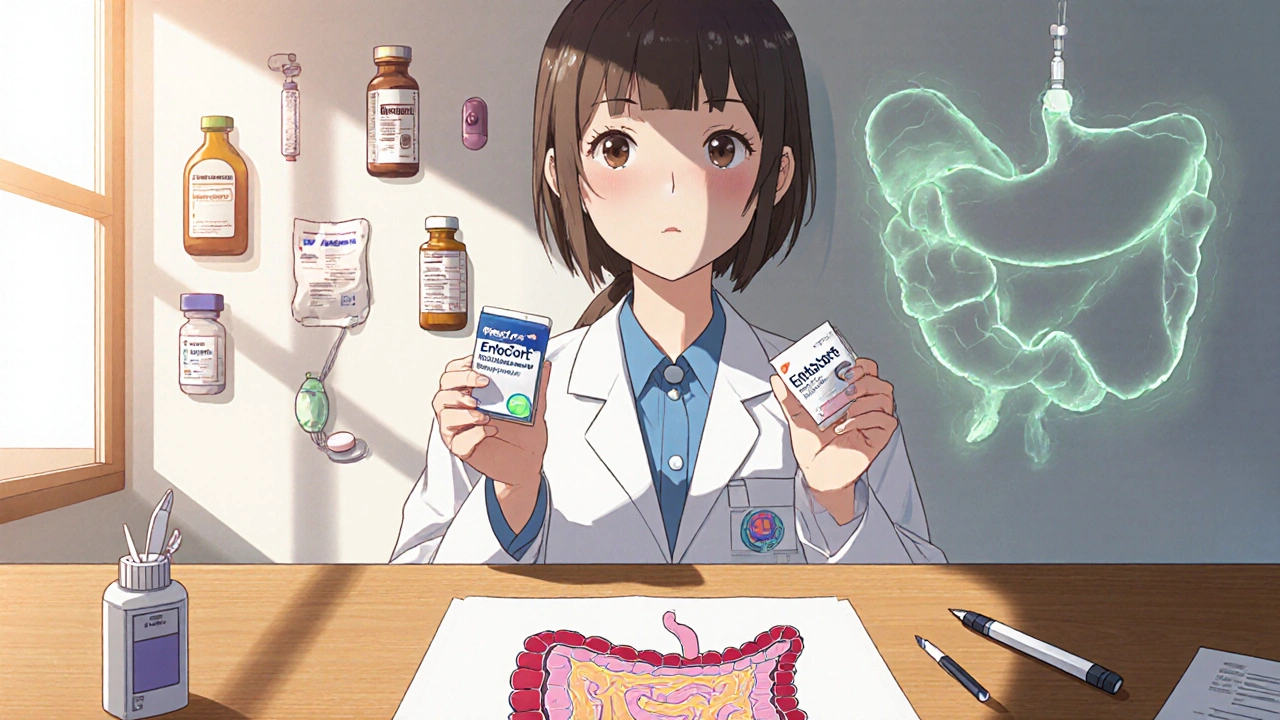When doctors prescribe a steroid for inflammatory bowel disease, Entocort is often on the shortlist. Its active ingredient, Budesonide, is a locally acting glucocorticoid designed to hit the gut while sparing the rest of the body. But is Entocort the best fit for every patient? Below you’ll find a side‑by‑side look at the most common alternatives, why they exist, and which scenarios tip the scales in their favor.
Why a Comparison Matters
Inflammatory bowel disease (IBD) isn’t one‑size‑fits‑all. Crohn’s disease and ulcerative colitis can flare up in different parts of the gastrointestinal tract, respond to medication differently, and carry unique side‑effect profiles. Choosing the right drug means balancing efficacy, safety, cost, and lifestyle considerations. A clear comparison helps you and your clinician make an evidence‑based decision instead of guessing.
Core Players: Entocort and Its Direct Cousins
First, let’s define the main drugs you’ll encounter.
- Entocort: Delayed‑release capsules containing 3 mg or 9 mg of Budesonide. Formulated to dissolve in the ileum and colon, it minimizes systemic absorption.
- Prednisone: A classic oral corticosteroid with strong systemic effects. Often used for severe flares or when a rapid response is needed.
- Mesalamine (also known as 5‑ASA): An anti‑inflammatory drug that stays in the gut lining, popular for mild‑to‑moderate ulcerative colitis.
- Azathioprine: An immunomodulator that reduces immune activity over weeks to months; used for maintenance therapy.
- Infliximab: A monoclonal antibody (anti‑TNF) given by IV infusion, reserved for refractory disease.
- Adalimumab: Another anti‑TNF, but self‑administered via subcutaneous injection.
- Vedolizumab: A gut‑selective integrin blocker, delivered intravenously, with a safer infection profile.
Comparison Table: Mechanism, Form, and Typical Use
| Drug | Class | Delivery Form | Typical Indication | Onset of Action | Main Advantages | Common Drawbacks |
|---|---|---|---|---|---|---|
| Entocort (Budesonide) | Topical glucocorticoid | Delayed‑release capsule | Moderate Crohn’s (ileum/ascending colon) & mild‑to‑moderate ulcerative colitis | 1-2 weeks | Low systemic exposure, good for long‑term use | May be less effective for severe flares |
| Prednisone | Systemic glucocorticoid | Oral tablet | Severe flares of Crohn’s or ulcerative colitis | Days | Rapid symptom control | Higher risk of weight gain, osteoporosis, glucose intolerance |
| Mesalamine | 5‑ASA anti‑inflammatory | Oral tablet, rectal suppository/enema | Mild‑to‑moderate ulcerative colitis | 2-4 weeks | Minimal steroid side effects | Limited efficacy in Crohn’s disease |
| Azathioprine | Immunomodulator | Oral tablet | Maintenance therapy for both Crohn’s & ulcerative colitis | 6-12 weeks | Reduces steroid dependence | Potential bone marrow suppression, requires TPMT testing |
| Infliximab | Anti‑TNF biologic | IV infusion | Moderate‑to‑severe disease refractory to steroids | 2-4 weeks (induction) | High remission rates | Infusion reactions, infection risk, expensive |
| Adalimumab | Anti‑TNF biologic | Subcutaneous injection | Similar to infliximab but self‑administered | 2-4 weeks (induction) | Convenient at‑home dosing | Injection site reactions, infection risk |
| Vedolizumab | Integrin antagonist | IV infusion | Patients who failed anti‑TNF therapy | 6-8 weeks (induction) | Gut‑specific; lower systemic infection risk | Slower onset, higher cost |
When Entocort Beats the Rest
Entocort shines in a few distinct scenarios:
- Targeted gut inflammation with minimal systemic fallout. Because budesonide undergoes extensive first‑pass metabolism, patients often avoid the weight gain and bone loss seen with prednisone.
- Patients with mild‑to‑moderate Crohn’s disease affecting the terminal ileum or right colon. The delayed‑release capsule releases the drug right where the disease lives.
- Long‑term maintenance when steroids are needed but systemic exposure must stay low. Many clinicians prescribe Entocort for 8‑12 weeks as a bridge to immunomodulators.
When an Alternative Is a Better Choice
Not every flare fits Entocort’s sweet spot. Consider these alternatives based on clinical picture:
- Severe, rapid‑onset flares: Prednisone’s systemic reach can calm a storm in days, buying time for slower‑acting agents.
- Predominant ulcerative colitis: Mesalamine offers a steroid‑free way to keep the lining calm, especially for patients wary of even low‑dose steroids.
- Need for steroid‑sparing maintenance: Azathioprine or mercaptopurine gradually shut down the immune over months, lowering long‑term steroid reliance.
- Biologic‑grade disease: Anti‑TNF agents (Infliximab, Adalimumab) are the go‑to for patients who no longer respond to steroids or immunomodulators.
- High infection risk or previous biologic failure: Vedolizumab’s gut‑selective mechanism offers a safer profile for immunocompromised individuals.
Side‑Effect Profile at a Glance
Understanding the safety trade‑offs helps you weigh the daily reality of each drug.
| Drug | Top 3 Side‑effects |
|---|---|
| Entocort (Budesonide) | Oral thrush, mild adrenal suppression, headache |
| Prednisone | Weight gain, glucose intolerance, osteoporosis |
| Mesalamine | Nausea, headache, rare renal dysfunction |
| Azathioprine | Liver enzyme elevation, leukopenia, pancreatitis |
| Infliximab | Infusion reactions, opportunistic infection, antibodies |
| Adalimumab | Injection site pain, respiratory infections, rash |
| Vedolizumab | Joint pain, nasopharyngitis, rare hepatitis |

Cost Considerations (2025 Approx.)
Price often decides between two clinically similar options. Below are ball‑park Australian dollars for a typical 30‑day supply:
- Entocort 9 mg capsule - ≈ $45 per month (generic budesonide slightly cheaper).
- Prednisone 10 mg tablet - ≈ $8 per month.
- Mesalamine (controlled‑release) - ≈ $70 per month.
- Azathioprine - ≈ $30 per month.
- Infliximab induction (5 mg/kg) - ≈ $2,400 per infusion, three infusions for induction.
- Adalimumab - ≈ $1,200 per month (self‑inject).
- Vedolizumab - ≈ $1,800 per infusion.
Insurance rebates and PBS listings can cut the out‑of‑pocket cost dramatically, especially for biologics under specialist prescription.
Practical Tips for Switching or Starting Therapy
- Ask about tapering. Jumping from prednisone to Entocort without a taper can trigger adrenal insufficiency.
- Check drug interactions. Budesonide is metabolized by CYP3A4; avoid strong inducers like rifampicin.
- Monitor labs. Azathioprine requires baseline CBC and liver tests; budesonide usually only needs periodic cortisol checks.
- Set realistic expectations. Biologicals may take 8‑12 weeks to show full remission; steroids act faster.
- Consider lifestyle. Subcutaneous injections can be done at home, while infusions require clinic visits.
Quick Takeaways
- Entocort delivers targeted steroids with low systemic risk-great for localized mild‑to‑moderate disease.
- Prednisone remains the rapid‑action backup for severe flares.
- Mesalamine is the first‑line steroid‑free option for ulcerative colitis.
- Azathioprine helps keep disease quiet over months, sparing steroids.
- Anti‑TNF biologics (Infliximab, Adalimumab) rescue patients who fail steroids or immunomodulators.
- Vedolizumab offers a gut‑specific, safer biologic but costs more and works slower.
Can I take Entocort and a probiotic at the same time?
Yes. Probiotics don’t interfere with budesonide’s absorption and can actually help manage mild diarrhea that sometimes occurs with IBD medications.
How long should I stay on Entocort before switching?
Most guidelines suggest a 8‑ to 12‑week course for induction. If symptoms persist beyond that, discuss escalation to immunomodulators or biologics with your gastroenterologist.
Is Entocort safe during pregnancy?
Budesonide is classified as pregnancy category B in Australia, meaning animal studies haven’t shown risk. Still, always consult your obstetrician before starting any steroid.
What should I do if I miss a dose of Entocort?
Take the missed capsule as soon as you remember, unless it’s almost time for the next dose. Don’t double‑up; just continue with the regular schedule.
How does the efficacy of Entocort compare to prednisone?
In Crohn’s disease limited to the terminal ileum, head‑to‑head trials show budesonide achieving similar remission rates to low‑dose prednisone, but with far fewer systemic side‑effects.
Choosing the right IBD medication isn’t a one‑off decision; it evolves with disease activity, personal health goals, and new drug options. Use this comparison as a roadmap, but always let a qualified gastroenterologist tailor the plan to your unique case.





4 Comments
kevin burton-24 October 2025
Entocort (budesonide) offers a targeted steroid approach for patients with mild‑to‑moderate Crohn’s disease confined to the ileum or right colon. Because the capsule releases the drug locally and undergoes extensive first‑pass metabolism, systemic exposure is low. This translates to a reduced risk of weight gain, osteoporosis, and glucose intolerance compared with prednisone. The typical induction course lasts eight to twelve weeks, after which many clinicians transition to an immunomodulator for maintenance. Cost‑wise, a 30‑day supply of the 9 mg capsules is around $45 in Australia, which is affordable for most insurance plans. If a patient experiences persistent symptoms beyond the induction period, escalation to azathioprine or a biologic should be considered. Monitoring cortisol levels is advisable only if treatment exceeds three months. Overall, Entocort balances efficacy and safety for localized disease.
Max Lilleyman- 6 November 2025
Wow, another “detailed” comparison that reads like a pharmacy brochure 🤦♂️. If you’re not willing to accept the obvious trade‑offs, stick to prednisone and stop whining 😒.
Benjamin Sequeira benavente-18 November 2025
Listen up folks this is the time to take control of your IBD journey! Entocort can be a game‑changer when used correctly, but don’t sit on the fence. Push for a proper taper plan and demand that your doctor monitors your labs. Your gut deserves the best, so be relentless!
Lisa Woodcock- 1 December 2025
I hear how overwhelming all these options can feel, especially when you’re juggling daily life. Think of Entocort as a bridge – it steadies the ship while you plan the next step. Stay patient and keep the conversation open with your gastroenterology team.